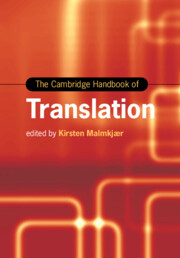Book contents
- The Cambridge Handbook of Translation
- Cambridge Handbooks in Language and Linguistics
- The Cambridge Handbook of Translation
- Copyright page
- Dedication
- Contents
- Figures
- Tables
- Contributors
- Acknowledgements
- Introduction
- Part I The Nature of Translation
- Part II Translation in Society
- Part III Translation in Company
- Part IV Translation in Practice: Factual Genres
- Part V Translation in Practice: Arts
- 21 Translating for the Theatre
- 22 Audiovisual Translation
- 23 Translating Literary Prose
- 24 Translating Poetry
- 25 Translating the Texts of Songs and Other Vocal Music
- Part VI Translation in History
- Index
- References
22 - Audiovisual Translation
from Part V - Translation in Practice: Arts
Published online by Cambridge University Press: 10 March 2022
- The Cambridge Handbook of Translation
- Cambridge Handbooks in Language and Linguistics
- The Cambridge Handbook of Translation
- Copyright page
- Dedication
- Contents
- Figures
- Tables
- Contributors
- Acknowledgements
- Introduction
- Part I The Nature of Translation
- Part II Translation in Society
- Part III Translation in Company
- Part IV Translation in Practice: Factual Genres
- Part V Translation in Practice: Arts
- 21 Translating for the Theatre
- 22 Audiovisual Translation
- 23 Translating Literary Prose
- 24 Translating Poetry
- 25 Translating the Texts of Songs and Other Vocal Music
- Part VI Translation in History
- Index
- References
Summary
Chapter 22 offers an overview of the field focusing on both established and emerging modalities, from traditional transfer modes such as dubbing, subtitling and voice-over, to modes that provide accessibility for people with sensory impairment, such as subtitling for the deaf and hard-of-hearing, audio description, live-subtitling and sign language. Non-professional translation practices such as fansubbing, fandubbing and film remaking are also discussed. For each mode, the chapter illustrates the associated medium-specific constraints and creative possibilities, highlighting the power of audiovisuals to contribute to meaning in ways that lend themselves to manipulation during the translation process.
Keywords
- Type
- Chapter
- Information
- The Cambridge Handbook of Translation , pp. 440 - 460Publisher: Cambridge University PressPrint publication year: 2022
References
- 1
- Cited by

